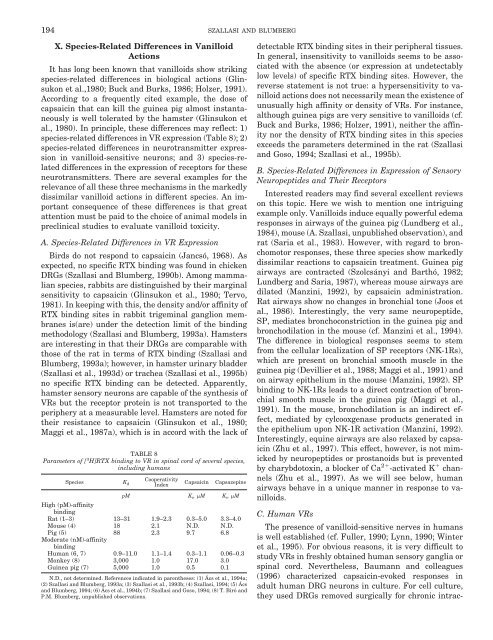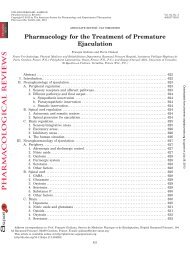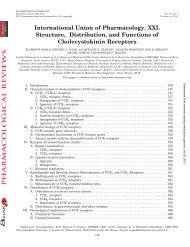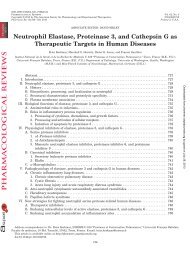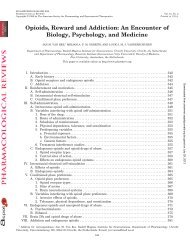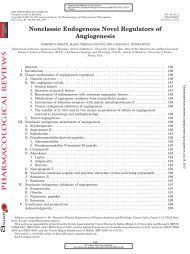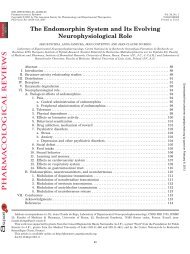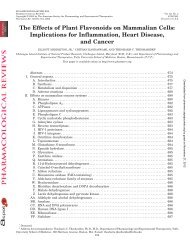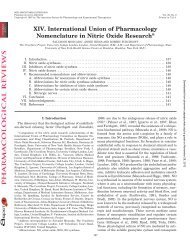Vanilloid (Capsaicin) Receptors and Mechanisms - Pharmacological ...
Vanilloid (Capsaicin) Receptors and Mechanisms - Pharmacological ...
Vanilloid (Capsaicin) Receptors and Mechanisms - Pharmacological ...
You also want an ePaper? Increase the reach of your titles
YUMPU automatically turns print PDFs into web optimized ePapers that Google loves.
194 SZALLASI AND BLUMBERG<br />
X. Species-Related Differences in <strong>Vanilloid</strong><br />
Actions<br />
It has long been known that vanilloids show striking<br />
species-related differences in biological actions (Glinsukon<br />
et al.,1980; Buck <strong>and</strong> Burks, 1986; Holzer, 1991).<br />
According to a frequently cited example, the dose of<br />
capsaicin that can kill the guinea pig almost instantaneously<br />
is well tolerated by the hamster (Glinsukon et<br />
al., 1980). In principle, these differences may reflect: 1)<br />
species-related differences in VR expression (Table 8); 2)<br />
species-related differences in neurotransmitter expression<br />
in vanilloid-sensitive neurons; <strong>and</strong> 3) species-related<br />
differences in the expression of receptors for these<br />
neurotransmitters. There are several examples for the<br />
relevance of all these three mechanisms in the markedly<br />
dissimilar vanilloid actions in different species. An important<br />
consequence of these differences is that great<br />
attention must be paid to the choice of animal models in<br />
preclinical studies to evaluate vanilloid toxicity.<br />
A. Species-Related Differences in VR Expression<br />
Birds do not respond to capsaicin (Jancsó, 1968). As<br />
expected, no specific RTX binding was found in chicken<br />
DRGs (Szallasi <strong>and</strong> Blumberg, 1990b). Among mammalian<br />
species, rabbits are distinguished by their marginal<br />
sensitivity to capsaicin (Glinsukon et al., 1980; Tervo,<br />
1981). In keeping with this, the density <strong>and</strong>/or affinity of<br />
RTX binding sites in rabbit trigeminal ganglion membranes<br />
is(are) under the detection limit of the binding<br />
methodology (Szallasi <strong>and</strong> Blumberg, 1993a). Hamsters<br />
are interesting in that their DRGs are comparable with<br />
those of the rat in terms of RTX binding (Szallasi <strong>and</strong><br />
Blumberg, 1993a); however, in hamster urinary bladder<br />
(Szallasi et al., 1993d) or trachea (Szallasi et al., 1995b)<br />
no specific RTX binding can be detected. Apparently,<br />
hamster sensory neurons are capable of the synthesis of<br />
VRs but the receptor protein is not transported to the<br />
periphery at a measurable level. Hamsters are noted for<br />
their resistance to capsaicin (Glinsukon et al., 1980;<br />
Maggi et al., 1987a), which is in accord with the lack of<br />
TABLE 8<br />
Parameters of [ 3 H]RTX binding to VR in spinal cord of several species,<br />
including humans<br />
Species K d<br />
Cooperativity<br />
Index<br />
<strong>Capsaicin</strong> Capsazepine<br />
pM Ki, M Ki, M<br />
High (pM)-affinity<br />
binding<br />
Rat (1–3) 13–31 1.9–2.3 0.3–5.0 3.3–4.0<br />
Mouse (4) 18 2.1 N.D. N.D.<br />
Pig (5)<br />
Moderate (nM)-affinity<br />
binding<br />
88 2.3 9.7 6.8<br />
Human (6, 7) 0.9–11.0 1.1–1.4 0.3–1.1 0.06–0.3<br />
Monkey (8) 3,000 1.0 17.0 3.0<br />
Guinea pig (7) 5,000 1.0 0.5 0.1<br />
N.D., not determined. References indicated in parentheses: (1) Ács et al., 1994a;<br />
(2) Szallasi <strong>and</strong> Blumberg, 1993a; (3) Szallasi et al., 1993b; (4) Szallasi, 1994; (5) Ács<br />
<strong>and</strong> Blumberg, 1994; (6) Ács et al., 1994b; (7) Szallasi <strong>and</strong> Goso, 1994; (8) T. Biró <strong>and</strong><br />
P.M. Blumberg, unpublished observations.<br />
detectable RTX binding sites in their peripheral tissues.<br />
In general, insensitivity to vanilloids seems to be associated<br />
with the absence (or expression at undetectably<br />
low levels) of specific RTX binding sites. However, the<br />
reverse statement is not true: a hypersensitivity to vanilloid<br />
actions does not necessarily mean the existence of<br />
unusually high affinity or density of VRs. For instance,<br />
although guinea pigs are very sensitive to vanilloids (cf.<br />
Buck <strong>and</strong> Burks, 1986; Holzer, 1991), neither the affinity<br />
nor the density of RTX binding sites in this species<br />
exceeds the parameters determined in the rat (Szallasi<br />
<strong>and</strong> Goso, 1994; Szallasi et al., 1995b).<br />
B. Species-Related Differences in Expression of Sensory<br />
Neuropeptides <strong>and</strong> Their <strong>Receptors</strong><br />
Interested readers may find several excellent reviews<br />
on this topic. Here we wish to mention one intriguing<br />
example only. <strong>Vanilloid</strong>s induce equally powerful edema<br />
responses in airways of the guinea pig (Lundberg et al.,<br />
1984), mouse (A. Szallasi, unpublished observation), <strong>and</strong><br />
rat (Saria et al., 1983). However, with regard to bronchomotor<br />
responses, these three species show markedly<br />
dissimilar reactions to capsaicin treatment. Guinea pig<br />
airways are contracted (Szolcsányi <strong>and</strong> Barthó, 1982;<br />
Lundberg <strong>and</strong> Saria, 1987), whereas mouse airways are<br />
dilated (Manzini, 1992), by capsaicin administration.<br />
Rat airways show no changes in bronchial tone (Joos et<br />
al., 1986). Interestingly, the very same neuropeptide,<br />
SP, mediates bronchoconstriction in the guinea pig <strong>and</strong><br />
bronchodilation in the mouse (cf. Manzini et al., 1994).<br />
The difference in biological responses seems to stem<br />
from the cellular localization of SP receptors (NK-1Rs),<br />
which are present on bronchial smooth muscle in the<br />
guinea pig (Devillier et al., 1988; Maggi et al., 1991) <strong>and</strong><br />
on airway epithelium in the mouse (Manzini, 1992). SP<br />
binding to NK-1Rs leads to a direct contraction of bronchial<br />
smooth muscle in the guinea pig (Maggi et al.,<br />
1991). In the mouse, bronchodilation is an indirect effect,<br />
mediated by cylcooxgenase products generated in<br />
the epithelium upon NK-1R activation (Manzini, 1992).<br />
Interestingly, equine airways are also relaxed by capsaicin<br />
(Zhu et al., 1997). This effect, however, is not mimicked<br />
by neuropeptides or prostanoids but is prevented<br />
by charybdotoxin, a blocker of Ca 2 -activated K channels<br />
(Zhu et al., 1997). As we will see below, human<br />
airways behave in a unique manner in response to vanilloids.<br />
C. Human VRs<br />
The presence of vanilloid-sensitive nerves in humans<br />
is well established (cf. Fuller, 1990; Lynn, 1990; Winter<br />
et al., 1995). For obvious reasons, it is very difficult to<br />
study VRs in freshly obtained human sensory ganglia or<br />
spinal cord. Nevertheless, Baumann <strong>and</strong> colleagues<br />
(1996) characterized capsaicin-evoked responses in<br />
adult human DRG neurons in culture. For cell culture,<br />
they used DRGs removed surgically for chronic intrac-


